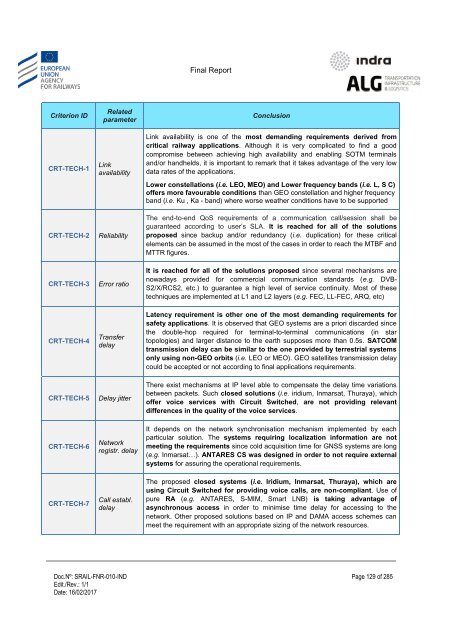Study on feasibility of SATCOM for railway communication
SRAIL-FNR-010-IND%20-%20FinalReport_v1.1_20170216
SRAIL-FNR-010-IND%20-%20FinalReport_v1.1_20170216
Create successful ePaper yourself
Turn your PDF publications into a flip-book with our unique Google optimized e-Paper software.
Final Report<br />
Criteri<strong>on</strong> ID<br />
CRT-TECH-1<br />
CRT-TECH-2<br />
Related<br />
parameter<br />
Link<br />
availability<br />
Reliability<br />
C<strong>on</strong>clusi<strong>on</strong><br />
Link availability is <strong>on</strong>e <strong>of</strong> the most demanding requirements derived from<br />
critical <strong>railway</strong> applicati<strong>on</strong>s. Although it is very complicated to find a good<br />
compromise between achieving high availability and enabling SOTM terminals<br />
and/or handhelds, it is important to remark that it takes advantage <strong>of</strong> the very low<br />
data rates <strong>of</strong> the applicati<strong>on</strong>s.<br />
Lower c<strong>on</strong>stellati<strong>on</strong>s (i.e. LEO, MEO) and Lower frequency bands (i.e. L, S C)<br />
<strong>of</strong>fers more favourable c<strong>on</strong>diti<strong>on</strong>s than GEO c<strong>on</strong>stellati<strong>on</strong> and higher frequency<br />
band (i.e. Ku , Ka - band) where worse weather c<strong>on</strong>diti<strong>on</strong>s have to be supported<br />
The end-to-end QoS requirements <strong>of</strong> a communicati<strong>on</strong> call/sessi<strong>on</strong> shall be<br />
guaranteed according to user‘s SLA. It is reached <strong>for</strong> all <strong>of</strong> the soluti<strong>on</strong>s<br />
proposed since backup and/or redundancy (i.e. duplicati<strong>on</strong>) <strong>for</strong> these critical<br />
elements can be assumed in the most <strong>of</strong> the cases in order to reach the MTBF and<br />
MTTR figures.<br />
CRT-TECH-3<br />
Error ratio<br />
It is reached <strong>for</strong> all <strong>of</strong> the soluti<strong>on</strong>s proposed since several mechanisms are<br />
nowadays provided <strong>for</strong> commercial communicati<strong>on</strong> standards (e.g. DVB-<br />
S2/X/RCS2, etc.) to guarantee a high level <strong>of</strong> service c<strong>on</strong>tinuity. Most <strong>of</strong> these<br />
techniques are implemented at L1 and L2 layers (e.g. FEC, LL-FEC, ARQ, etc)<br />
CRT-TECH-4<br />
Transfer<br />
delay<br />
Latency requirement is other <strong>on</strong>e <strong>of</strong> the most demanding requirements <strong>for</strong><br />
safety applicati<strong>on</strong>s. It is observed that GEO systems are a priori discarded since<br />
the double-hop required <strong>for</strong> terminal-to-terminal communicati<strong>on</strong>s (in star<br />
topologies) and larger distance to the earth supposes more than 0.5s. <strong>SATCOM</strong><br />
transmissi<strong>on</strong> delay can be similar to the <strong>on</strong>e provided by terrestrial systems<br />
<strong>on</strong>ly using n<strong>on</strong>-GEO orbits (i.e. LEO or MEO). GEO satellites transmissi<strong>on</strong> delay<br />
could be accepted or not according to final applicati<strong>on</strong>s requirements.<br />
CRT-TECH-5<br />
Delay jitter<br />
There exist mechanisms at IP level able to compensate the delay time variati<strong>on</strong>s<br />
between packets. Such closed soluti<strong>on</strong>s (i.e. iridium, Inmarsat, Thuraya), which<br />
<strong>of</strong>fer voice services with Circuit Switched, are not providing relevant<br />
differences in the quality <strong>of</strong> the voice services.<br />
CRT-TECH-6<br />
Network<br />
registr. delay<br />
It depends <strong>on</strong> the network synchr<strong>on</strong>isati<strong>on</strong> mechanism implemented by each<br />
particular soluti<strong>on</strong>. The systems requiring localizati<strong>on</strong> in<strong>for</strong>mati<strong>on</strong> are not<br />
meeting the requirements since cold acquisiti<strong>on</strong> time <strong>for</strong> GNSS systems are l<strong>on</strong>g<br />
(e.g. Inmarsat…). ANTARES CS was designed in order to not require external<br />
systems <strong>for</strong> assuring the operati<strong>on</strong>al requirements.<br />
CRT-TECH-7<br />
Call establ.<br />
delay<br />
The proposed closed systems (i.e. Iridium, Inmarsat, Thuraya), which are<br />
using Circuit Switched <strong>for</strong> providing voice calls, are n<strong>on</strong>-compliant. Use <strong>of</strong><br />
pure RA (e.g. ANTARES, S-MIM, Smart LNB) is taking advantage <strong>of</strong><br />
asynchr<strong>on</strong>ous access in order to minimise time delay <strong>for</strong> accessing to the<br />
network. Other proposed soluti<strong>on</strong>s based <strong>on</strong> IP and DAMA access schemes can<br />
meet the requirement with an appropriate sizing <strong>of</strong> the network resources.<br />
Doc.Nº: SRAIL-FNR-010-IND<br />
Edit./Rev.: 1/1<br />
Date: 16/02/2017<br />
Page 129 <strong>of</strong> 285


